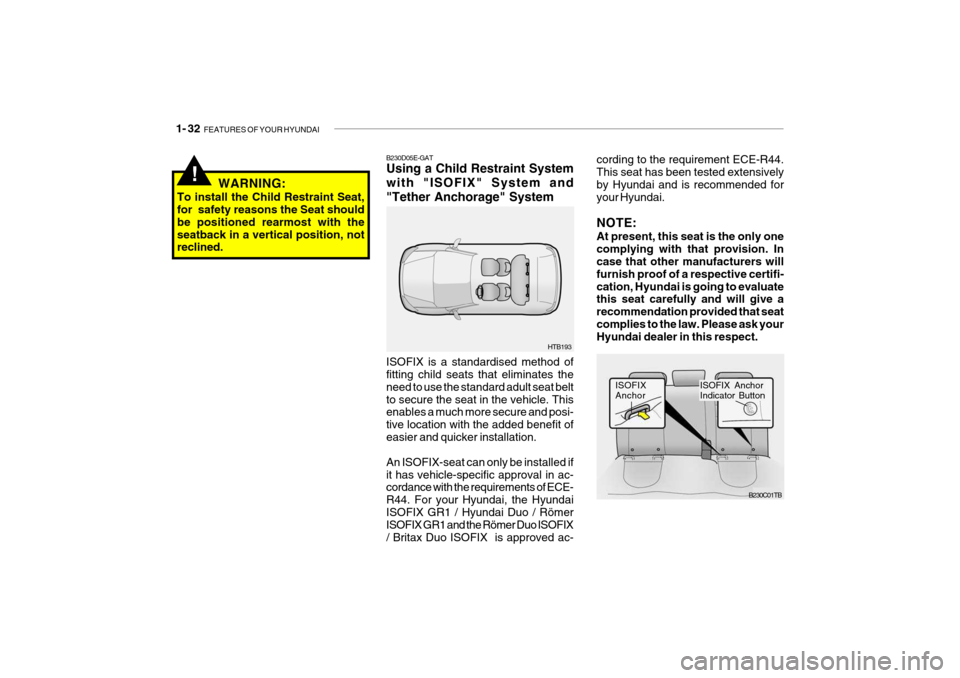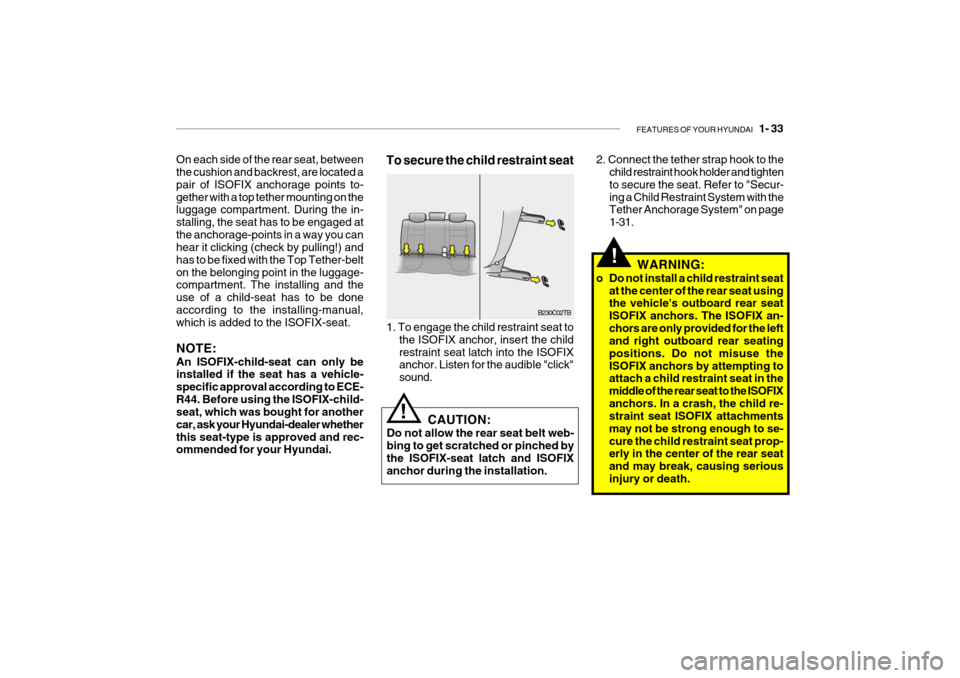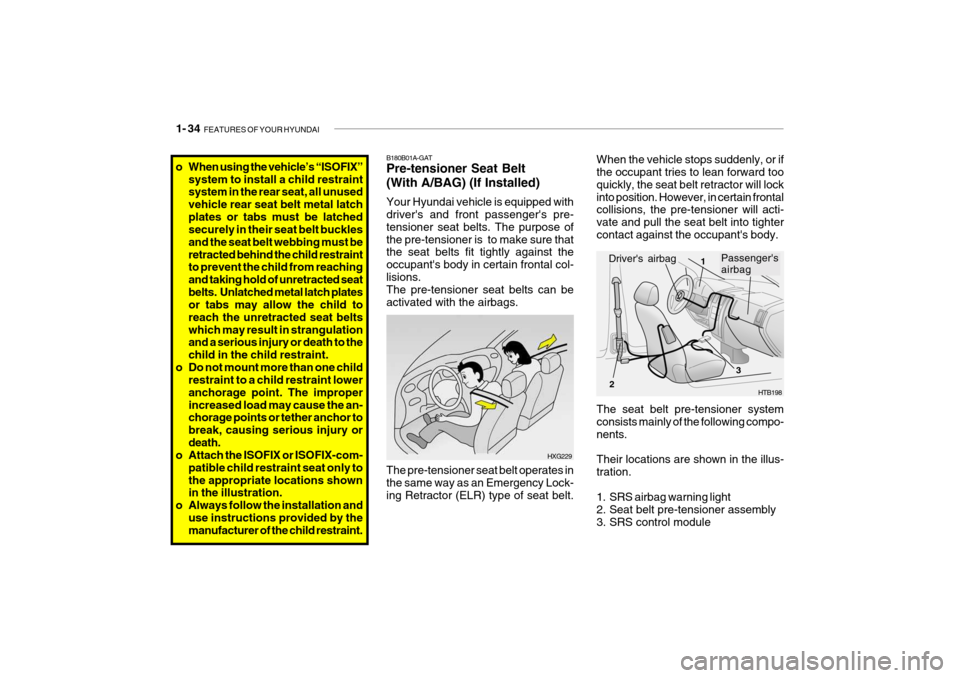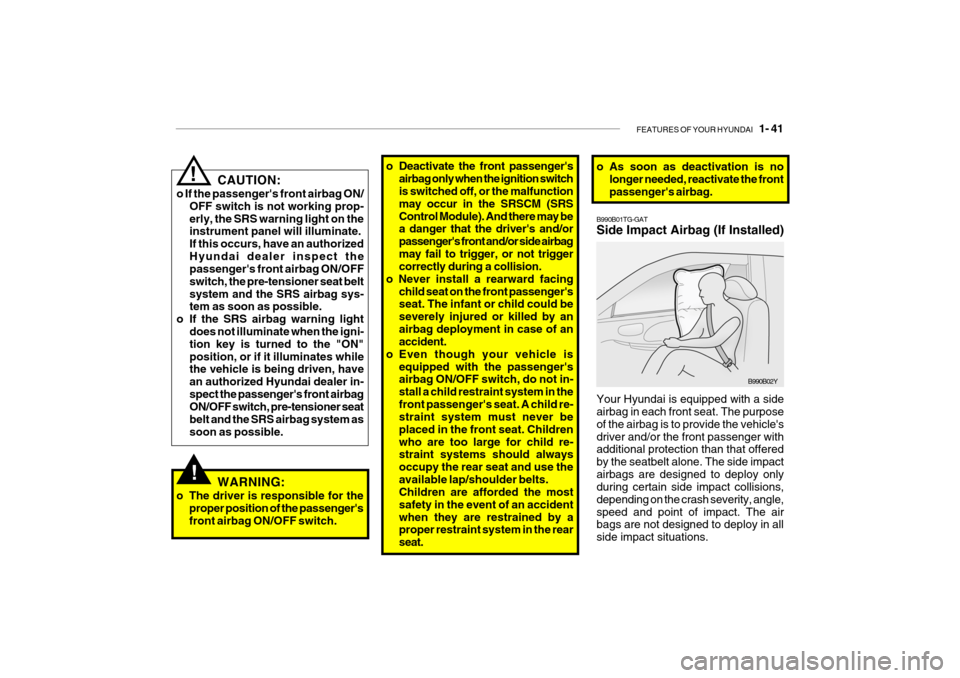2007 Hyundai Getz child seat
[x] Cancel search: child seatPage 42 of 463

1- 30 FEATURES OF YOUR HYUNDAI
U : Suitable for "universal" category restraints approved for use in this mass group UF :Suitable for forward-facing "universal" category restraints approved for the use in this mass group
L1 : Suitable for Bebe comfort ELIOS (E2 037014) approved for the use in this mass group
L2 : Suitable for PegPerego primo Viaggio (E13 030010) approved for the use in this mass group
L3 : Suitable for Bebe comfort iSEOS (E2 039014) approved for the use in this mass group
L4 : Suitable for GRACO Autobaby (E11 03.44.160) approved for the use in this mass group
L5 : Suitable for Romer Lord Plus (E1 03301136) approved for the use in this mass group
L6 : Suitable for Euro Kids Star (E1 03301127/E1 03301129) approved for the use in this mass group
L7 : Suitable for BeSafe iZi COMFORT (E4 03443206) approved for the use in this mass group
L8 : Suitable for MAXI-COSI Priori XP (E1 03301153) approved for the use in this mass group
L9 : Suitable for Bebe comfort HiPSOS(E2 031011) approved for the use in this mass group
L10 : Suitable for ROMER ISOFIX GR1 (E1 R44-03301133) approved for use in this mass group
X : Seat position not suitable for children in this mass group
B230H03TB-GAT Child Seat Restraint Suitability For Seat Position Using the Seatbelt Use child safety seats that have been officially approved and are appropriate for your children. When using the child safety se
ats,
refer to the following table.
Rear Center
Age GroupSeating Position
UX
L1, L2, L3, L4 UX
Rear Outboard
Front Passenger
0 : Up to 10 kg (0 ~ 9 months)0+ : Up to 13 kg(0 ~ 2 years)I : 9kg to 18kg(9 months ~ 4 years)II & III : 15kg to 36kg(4 ~ 12 years) L1, L2, L3, L4
L3, L5, L6, L7, L8
U, L10X
L6, L9 U F X
Page 43 of 463

FEATURES OF YOUR HYUNDAI 1- 31
B230E01TB
Back panel
Front of Vehicle
Attaching clip
Covering shelf
2. Remove the load space cover.
3. Connect the tether strap hook to the child restraint hook holder and tighten to secure the seat.
B230B01TB
B230B02A-GAT Using a Child Restraint System with "Tether Anchorage" Sys-tem For small children and babies, the use of a child seat or infant seat is stronglyrecommended. This child seat or infant seat should be of appropriate size for the child and should be installed inaccordance with the manufacturer's in- structions. It is further recommended that the seat be placed in the vehicle'srear seat since this can make an impor- tant contribution to safety. Your vehicle is provided with three child restrainthook holders for installing the child seat or infant seat. Spacer (10mm), Child Restraint Hook Holder
Holder Bolt (5/16"-30 mm) Washer, Conical Spring Holder, Child Restraint Hook
Retainer Washer B230E02FC-GAT Securing a Child Restraint Sys- tem with "Tether Anchorage"System Three child restraint hook holders are located on the vertical back panel. (behind rear bumper bar)
1. Route the child restraint seat strap
over the seatback. For vehicles with adjustable head- rests, route the tether strap under the headrest and between the head-rest posts, otherwise route the tether strap over the top of the seatback.
Page 44 of 463

1- 32 FEATURES OF YOUR HYUNDAI
!WARNING:
To install the Child Restraint Seat, for safety reasons the Seat should be positioned rearmost with theseatback in a vertical position, not reclined. B230D05E-GAT Using a Child Restraint System with "ISOFIX" System and"Tether Anchorage" System ISOFIX is a standardised method of fitting child seats that eliminates the need to use the standard adult seat beltto secure the seat in the vehicle. This enables a much more secure and posi- tive location with the added benefit ofeasier and quicker installation. An ISOFIX-seat can only be installed if it has vehicle-specific approval in ac- cordance with the requirements of ECE- R44. For your Hyundai, the HyundaiISOFIX GR1 / Hyundai Duo / Römer ISOFIX GR1 and the Römer Duo ISOFIX / Britax Duo ISOFIX is approved ac-
HTB193cording to the requirement ECE-R44. This seat has been tested extensively by Hyundai and is recommended foryour Hyundai. NOTE: At present, this seat is the only one complying with that provision. In case that other manufacturers will furnish proof of a respective certifi-cation, Hyundai is going to evaluate this seat carefully and will give a recommendation provided that seatcomplies to the law. Please ask your Hyundai dealer in this respect.
B230C01TB
ISOFIX Anchor
ISOFIX Anchor Indicator Button
Page 45 of 463

FEATURES OF YOUR HYUNDAI 1- 33
WARNING:
o Do not install a child restraint seat at the center of the rear seat using the vehicle's outboard rear seat ISOFIX anchors. The ISOFIX an-chors are only provided for the left and right outboard rear seating positions. Do not misuse theISOFIX anchors by attempting to attach a child restraint seat in the middle of the rear seat to the ISOFIXanchors. In a crash, the child re- straint seat ISOFIX attachments may not be strong enough to se-cure the child restraint seat prop- erly in the center of the rear seat and may break, causing seriousinjury or death.!
On each side of the rear seat, between the cushion and backrest, are located a pair of ISOFIX anchorage points to-gether with a top tether mounting on the luggage compartment. During the in- stalling, the seat has to be engaged atthe anchorage-points in a way you can hear it clicking (check by pulling!) and has to be fixed with the Top Tether-belton the belonging point in the luggage- compartment. The installing and the use of a child-seat has to be doneaccording to the installing-manual, which is added to the ISOFIX-seat. NOTE: An ISOFIX-child-seat can only be installed if the seat has a vehicle- specific approval according to ECE-R44. Before using the ISOFIX-child- seat, which was bought for another car, ask your Hyundai-dealer whetherthis seat-type is approved and rec- ommended for your Hyundai. B230C02TB
1. To engage the child restraint seat to the ISOFIX anchor, insert the child restraint seat latch into the ISOFIX anchor. Listen for the audible "click" sound.
To secure the child restraint seat2. Connect the tether strap hook to the
child restraint hook holder and tighten to secure the seat. Refer to "Secur-ing a Child Restraint System with the Tether Anchorage System" on page 1-31.
! CAUTION:
Do not allow the rear seat belt web- bing to get scratched or pinched bythe ISOFIX-seat latch and ISOFIX anchor during the installation.
Page 46 of 463

1- 34 FEATURES OF YOUR HYUNDAI
o When using the vehicle’s “ISOFIX”
system to install a child restraint system in the rear seat, all unused vehicle rear seat belt metal latchplates or tabs must be latched securely in their seat belt buckles and the seat belt webbing must beretracted behind the child restraint to prevent the child from reaching and taking hold of unretracted seat
belts. Unlatched metal latch plates or tabs may allow the child to reach the unretracted seat beltswhich may result in strangulation and a serious injury or death to the child in the child restraint.
o Do not mount more than one child restraint to a child restraint loweranchorage point. The improperincreased load may cause the an- chorage points or tether anchor to break, causing serious injury ordeath.
o Attach the ISOFIX or ISOFIX-com-
patible child restraint seat only tothe appropriate locations shown in the illustration.
o Always follow the installation and use instructions provided by themanufacturer of the child restraint. The pre-tensioner seat belt operates inthe same way as an Emergency Lock- ing Retractor (ELR) type of seat belt.
HXG229
B180B01A-GAT Pre-tensioner Seat Belt (With A/BAG) (If Installed) Your Hyundai vehicle is equipped with driver's and front passenger's pre- tensioner seat belts. The purpose ofthe pre-tensioner is to make sure that the seat belts fit tightly against the occupant's body in certain frontal col-lisions. The pre-tensioner seat belts can be activated with the airbags.
When the vehicle stops suddenly, or if the occupant tries to lean forward too quickly, the seat belt retractor will lockinto position. However, in certain frontal collisions, the pre-tensioner will acti- vate and pull the seat belt into tightercontact against the occupant's body.
The seat belt pre-tensioner system consists mainly of the following compo- nents. Their locations are shown in the illus- tration.
1. SRS airbag warning light
2. Seat belt pre-tensioner assembly
3. SRS control module
HTB198
Driver's airbag1
2 3Passenger's airbag
Page 49 of 463

FEATURES OF YOUR HYUNDAI 1- 37
could be severely injured or killed by an airbag deployment in case of an accident.
o Do not allow children to ride in the front passenger seat. If olderchildren (teenagers and older)must ride in the front seat, make sure they are always properly belted and that the seat is movedback as far as possible.
o For maximum safety protection
in all types of crashes, all occu-pants including the driver should always wear their seat belts whether or not an airbag is alsoprovided at their seating posi- tion to minimize the risk of se- vere injury or death in the eventof a crash. Do not sit or lean unnecessarily close to the airbag while the vehicle is in motion.
o The SRS airbag system must de- ploy very rapidly to provide pro-tection in a crash. If an occupantis out of position because of not wearing a seat belt, the airbag may forcefully contact the occu-pant causing serious or fatal in- juries.
HTB203
Rear impact
Side Impact Rollover
o Front airbags are not intended to deploy in side-impact, rear-im- pact or rollover crashes. In addi-tion, airbags will not deploy in frontal crashes below the deploy- ment threshold speed.
o The SRS is designed to deploy the
airbags only when an impact issufficiently severe and when theimpact angle is less than 30° from the forward longitudinal axis of the vehicle and will not deploy inside, rear or rollover impacts. Ad- ditionally, the airbags will only deploy once. Thus, seat beltsmust be worn at all times. o The driver should sit back as far as
possible while still maintainingcontrol of the vehicle. If you aresitting too close to the airbag, it can cause death or serious injury when it inflates.
o No objects should be placed over or near the airbag modules onthe steering wheel, instrumentpanel, and the front passenger's panel above the glove box, because any such object couldcause harm if the vehicle is in a crash severe enough to cause the airbags to deploy.
o If the airbags deploy, they must be replaced by an authorizedHyundai dealer.
o Do not tamper with or discon- nect SRS wiring, or other com-ponents of the SRS system. Do-ing so could result in injury, due to accidental firing of the airbags or by rendering the SRS inopera-tive.
o Do not install a child restraint
system in the front passengerseat position. A child restraint system must never be placed in the front seat. The infant or child
Page 52 of 463

1- 40 FEATURES OF YOUR HYUNDAI
B240C01NF
o The SRS can function only when
the ignition key is in the "ON" position. If the SRS SRI does not come on, or continuously re-mains on, after flashing for about 6 seconds when the ignition key is turned to the "ON" position, orafter the engine is started, or comes on while driving, the SRS is not working properly. If thisoccurs, have your vehicle imme- diately inspected by your Hyundai dealer.
o Before you replace a fuse or dis- connect a battery terminal, turnthe ignition key to the "LOCK"position or remove the ignition key. Never remove or replace the air bag related fuse(s) when theignition key is in the "ON" posi- tion. Failure to heed this warning will cause the SRS SRI to illumi-nate.B990A01TB-GAT Passenger's Front Airbag ON/ OFF Switch (If Installed)
B990A01TB
The passenger's front airbag can be deactivated by the passenger's frontairbag ON/OFF switch (1) if a child restraint is installed on the front passenger's seat or if the frontpassenger's seat is unoccupied by a person. To ensure the safety of your child, thepassenger's front airbag must be deac- tivated when it should be necessary to install a rearward facing child seat onthe front passenger seat in exceptional circumstances. (1)
To deactivate or reactivate the passenger's front airbag To deactivate the passenger's front airbag, insert the master key into the passenger's front airbag ON/OFF switchon the right side of the crash pad and turn it to the "OFF" position. The passenger's front airbag OFF indicatorwill illuminate and stay on until the passenger's front airbag is reactivated. To reactivate the passenger's front airbag, insert the master key into the passenger's front airbag ON/OFF switchand turn it to the "ON" position. The passenger's front airbag OFF indicator will go out.
Page 53 of 463

FEATURES OF YOUR HYUNDAI 1- 41
!WARNING:
o The driver is responsible for the proper position of the passenger's front airbag ON/OFF switch.
! CAUTION:
o If the passenger's front airbag ON/ OFF switch is not working prop- erly, the SRS warning light on the instrument panel will illuminate. If this occurs, have an authorizedHyundai dealer inspect the passenger's front airbag ON/OFF switch, the pre-tensioner seat beltsystem and the SRS airbag sys- tem as soon as possible.
o If the SRS airbag warning light
does not illuminate when the igni-tion key is turned to the "ON" position, or if it illuminates while the vehicle is being driven, have an authorized Hyundai dealer in-spect the passenger's front airbag ON/OFF switch, pre-tensioner seat belt and the SRS airbag system assoon as possible.o Deactivate the front passenger'sairbag only when the ignition switch is switched off, or the malfunction may occur in the SRSCM (SRSControl Module). And there may be a danger that the driver's and/or passenger's front and/or side airbagmay fail to trigger, or not trigger correctly during a collision.
o Never install a rearward facing child seat on the front passenger'sseat. The infant or child could be severely injured or killed by anairbag deployment in case of an accident.
o Even though your vehicle is equipped with the passenger'sairbag ON/OFF switch, do not in- stall a child restraint system in thefront passenger's seat. A child re- straint system must never be placed in the front seat. Childrenwho are too large for child re- straint systems should always occupy the rear seat and use theavailable lap/shoulder belts. Children are afforded the most safety in the event of an accidentwhen they are restrained by a proper restraint system in the rear seat. B990B01TG-GAT Side Impact Airbag (If Installed) Your Hyundai is equipped with a side airbag in each front seat. The purpose of the airbag is to provide the vehicle'sdriver and/or the front passenger with additional protection than that offered by the seatbelt alone. The side impactairbags are designed to deploy only during certain side impact collisions, depending on the crash severity, angle,speed and point of impact. The air bags are not designed to deploy in all side impact situations.
B990B02Y
o As soon as deactivation is no
longer needed, reactivate the front passenger's airbag.